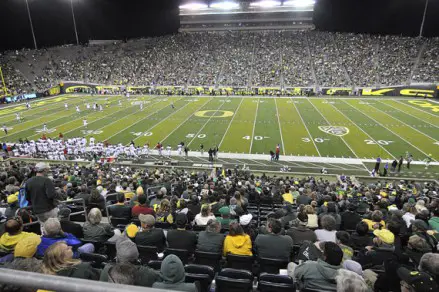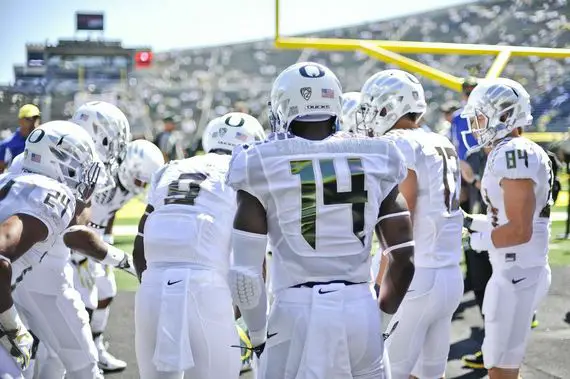Quick, answer a seemingly impossible question, “What will Oregon’s football program look like in 10 years?” What about these, “Who will be the powerful programs within a conference as up in the air as the Pac-12?” ”How long will the college playoff system remain at only four teams?” (Some might even predict that the NCAA won’t even be around in a decade, but that’s an argument for a different time.)
And – ”Where do you rank Oregon’s football program compared to other programs across the country?” ”If Alabama, Ohio State and others are the top tier of programs, how far behind are the Ducks, or do you think they’re already there?”
The reason I bring this up stems from comments made by Oregon’s Athletic Director, Rob Mullens, who gave an insightful interview to John Canzano of Oregonlive.com, where he addresses some of the potential changes coming to the football program’s infrastructure, college football as a whole and what the future might look like for this football team we regard so highly.
As we all know, Oregon beat Texas in last year’s Alamo Bowl. But, while the Longhorns were certainly in a down year, it’s never a bad thing to beat a legendary program, and in their own backyard while you’re at it. Unfortunately though, one game doesn’t define a program, UO isn’t quite there in terms of being an A+ program, but we certainly know that Oregon has laid the groundwork on becoming not only the premiere program of the West Coast, but one of the premiere programs nationwide. It’s been 20 years since arguably the most famous play in Ducks football history, “The Pick,” and since then they’ve flown up the ranks of college football faster than Kenny Wheaton racing to the endzone.
What’s clear after reading through this interview, is that Mullens, and the university overall, plan on staying in contention for national championships for years to come, and for Oregon to be the newest addition to the truly elite football programs.
When asked about what UO is doing as a program compared to other schools, Mullens said, “We’re very in tune with what’s happening, but it’s not mutually exclusive with us. It’s any and all. We’re in tune with what’s being built in our league. But we’re paying attention to what Texas, Ohio State, Florida and Michigan are doing, too.”
What so encourages me about Mullens is that he doesn’t appear content to just compete with teams from the Pac-12. While there are certainly some good programs here out west, to compete with schools all across the country, you have to be not just good, but great.
With the new landscape of college football, one that features a new playoff system, schools across America have made a conceited effort to improve the profile of their programs, in hopes that they receive an invite to the exclusive four-team playoff.
The one name in that list that struck a particular chord was Ohio State. As many know, the Buckeyes played the spoiler when they defeated Oregon in the 2010 Rose Bowl, where Chip Kelly’s first season as head coach ended in defeat. What’s also interesting to note about the Buckeyes, is that Oregon has scheduled a home-and-home series with Ohio State, that takes place over the 2020 and 2021 seasons. While not exactly a decade away as originally proposed, will Oregon have bridged the gap between themselves and the most recognizable and respected college football programs by the time these games are played?
Mullens, in his interview, compared Oregon to these programs he listed, “When you look at us, and where we’re competing across the board, but mostly in football, we’re competing with a 55,000-seat football facility and we’re competing against programs that have stadiums with 85,000 seats.” [Ed. note: That 30,000 patron difference equates to about $1.5 million at $50 a ticket — per home game. Many stadiums seat closer to 100,000 fans.]
While expansion of Autzen Stadium has been discussed, many believe it would not be feasible to expand seating a significant amount, given the lack of demand for several games each season, and how Eugene isn’t exactly a Big City. Even though Autzen certainly ranks high nationwide in terms of stadium experience, it’s official capacity is 53,800, which is barely over half the size of Ohio Stadium where the Buckeyes play, seating 102,329 fans, officially.
Eugene also reaps praise for being a tough place to play, but having the loudest stadium around doesn’t make up for the added revenue of selling 50,000 additional tickets. If the Ducks want to knock on the door of the elite programs, it has to look elsewhere to continue making their gains on the college football heavyweights.

With a stadium that seats only half as many fans as many elite football schools, is expansion on the way?
Mullens’ comments speak toward UO’s embrace of the future. In a stroke of genius, Oregon separated itself from other programs, while making sure they are mentioned in the same breath at the same time. While other programs flaunt their storied past, Oregon strives to constantly point toward an exciting future, one filled with flashy helmets and breathtaking facilities.
With Oregon’s lack of a storied past, one that includes waiting 95 years between Rose Bowl victories, the future is Oregon’s best asset. Adapting the “you vs yesterday” mindset has given the Ducks the pole position in the race to redefine college football in the new era.
Top photo by Kevin Cline
Related Articles:
Chip Kelly Update: Everything's Good Again ...
Chip Kelly Update: Wailing and Gnashing of Teeth
Shock and Awe -- The Oregon Ducks' Football Hangover Effect
Despite Lopsided Score, Georgia State "Never Stopped Believing"
Hope Springs Eternal for Ducks
Incompetent Pac-12 Officials: How Do You Miss ALL of THIS?
Originally from San Diego, Steven decided to take a shot on attending a school over 1000 miles from home, and he’s been happy ever since. Steven graduated from the University of Oregon in 2013, and his passion for sports has followed him into his post-college life. A huge fan of both basketball and football, Steven enjoys incorporating both statistics and his own personal beliefs into his writing. When he’s not watching sports, Steven is currently training for his first half-marathon, and is looking to run a few more in the future. You can follow Steven on Twitter at @StevenHolstad


